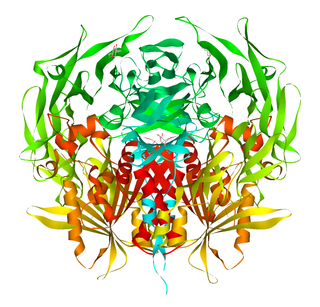
Pro-opiomelanocortin (POMC) is a precursor polypeptide with 241 amino acid residues. POMC is synthesized in corticotrophs of the anterior pituitary from the 267-amino-acid-long polypeptide precursor pre-pro-opiomelanocortin (pre-POMC), by the removal of a 26-amino-acid-long signal peptide sequence during translation. POMC is part of the central melanocortin system.

Dipeptidyl peptidase-4, also known as adenosine deaminase complexing protein 2 or CD26 is a protein that, in humans, is encoded by the DPP4 gene. DPP4 is related to FAP, DPP8, and DPP9. The enzyme was discovered in 1966 by Hopsu-Havu and Glenner, and as a result of various studies on chemism, was called dipeptidyl peptidase IV [DP IV].
In molecular biology, the Signal Peptide Peptidase (SPP) is a type of protein that specifically cleaves parts of other proteins. It is an intramembrane aspartyl protease with the conserved active site motifs 'YD' and 'GxGD' in adjacent transmembrane domains (TMDs). Its sequences is highly conserved in different vertebrate species. SPP cleaves remnant signal peptides left behind in membrane by the action of signal peptidase and also plays key roles in immune surveillance and the maturation of certain viral proteins.

Aminomethyltransferase is an enzyme that catabolizes the creation of methylenetetrahydrofolate. It is part of the glycine decarboxylase complex.

Membrane-bound transcription factor site-1 protease, or site-1 protease (S1P) for short, also known as subtilisin/kexin-isozyme 1 (SKI-1), is an enzyme that in humans is encoded by the MBTPS1 gene. S1P cleaves the endoplasmic reticulum loop of sterol regulatory element-binding protein (SREBP) transcription factors.

Serine protease HTRA2, mitochondrial is an enzyme that in humans is encoded by the HTRA2 gene. This protein is involved in caspase-dependent apoptosis and in Parkinson's disease.

Minor histocompatibility antigen H13 is a protein that in humans is encoded by the HM13 gene.

Lon protease homolog, mitochondrial is a protease, an enzyme that in humans is encoded by the LONP1 gene.

Signal peptide peptidase-like 2B, also known as SPPL2B, is a human gene.

Mitochondrial-processing peptidase subunit beta is an enzyme that in humans is encoded by the PMPCB gene. This gene is a member of the peptidase M16 family and encodes a protein with a zinc-binding motif. This protein is located in the mitochondrial matrix and catalyzes the cleavage of the leader peptides of precursor proteins newly imported into the mitochondria, though it only functions as part of a heterodimeric complex.

Mitochondrial-processing peptidase subunit alpha is an enzyme that in humans is encoded by the PMPCA gene. This gene PMPCA encoded a protein that is a member of the peptidase M16 family. This protein is located in the mitochondrial matrix and catalyzes the cleavage of the leader peptides of precursor proteins newly imported into the mitochondria, though it only functions as part of a heterodimeric complex.

CAAX prenyl protease 2 is an enzyme that in humans is encoded by the RCE1 gene.

ATP-dependent Clp protease proteolytic subunit (ClpP) is an enzyme that in humans is encoded by the CLPP gene. This protein is an essential component to form the protein complex of Clp protease.

Hydroxyacyl-Coenzyme A dehydrogenase (HADH) is an enzyme which in humans is encoded by the HADH gene.
Mitochondrial processing peptidase is an enzyme complex found in mitochondria which cleaves signal sequences from mitochondrial proteins. In humans this complex is composed of two subunits encoded by the genes PMPCA, and PMPCB. The enzyme is also known as. This enzyme catalyses the following chemical reaction

Metalloendopeptidase OMA1, mitochondrial is an enzyme that in humans is encoded by the OMA1 gene. OMA1 is a Zn2+-dependent metalloendopeptidase in the inner membrane of mitochondria. The OMA1 acronym was derived from overlapping proteolytic activity with m-AAA protease 1.

Inner mitochondrial membrane peptidase subunit 2 (IMMP2L) is an enzyme that in humans is encoded by the IMMP2L gene on chromosome 7. This protein catalyzes the removal of transit peptides required for the targeting of proteins from the mitochondrial matrix, across the inner membrane, into the intermembrane space. IMMP2L processes the nuclear encoded protein DIABLO.

Cytochrome c oxidase assembly factor 3, also known as Coiled-coil domain-containing protein 56, or Mitochondrial translation regulation assembly intermediate of cytochrome c oxidase protein of 12 kDa is a protein that in humans is encoded by the COA3 gene. This gene encodes a member of the cytochrome c oxidase assembly factor family. Studies of a related gene in fly suggest that the encoded protein is localized to mitochondria and is essential for cytochrome c oxidase function.

Cytochrome c oxidase assembly factor COX14 is a protein that in humans is encoded by the COX14 gene. This gene encodes a small single-pass transmembrane protein that localizes to mitochondria. This protein may play a role in coordinating the early steps of cytochrome c oxidase subunit assembly and, in particular, the synthesis and assembly of the COX I subunit of the holoenzyme. Mutations in this gene have been associated with mitochondrial complex IV deficiency. Alternative splicing results in multiple transcript variants.

Cytochrome c oxidase assembly factor 6 is a protein that in humans is encoded by the COA6 gene. Mitochondrial respiratory chain Complex IV, or cytochrome c oxidase, is the component of the respiratory chain that catalyzes the transfer of electrons from intermembrane space cytochrome c to molecular oxygen in the matrix and as a consequence contributes to the proton gradient involved in mitochondrial ATP synthesis. The COA6 gene encodes an assembly factor for mitochondrial complex IV and is a member of the cytochrome c oxidase subunit 6B family. This protein is located in the intermembrane space, associating with SCO2 and COX2. It stabilizes newly formed COX2 and is part of the mitochondrial copper relay system. Mutations in this gene result in fatal infantile cardioencephalomyopathy.


















